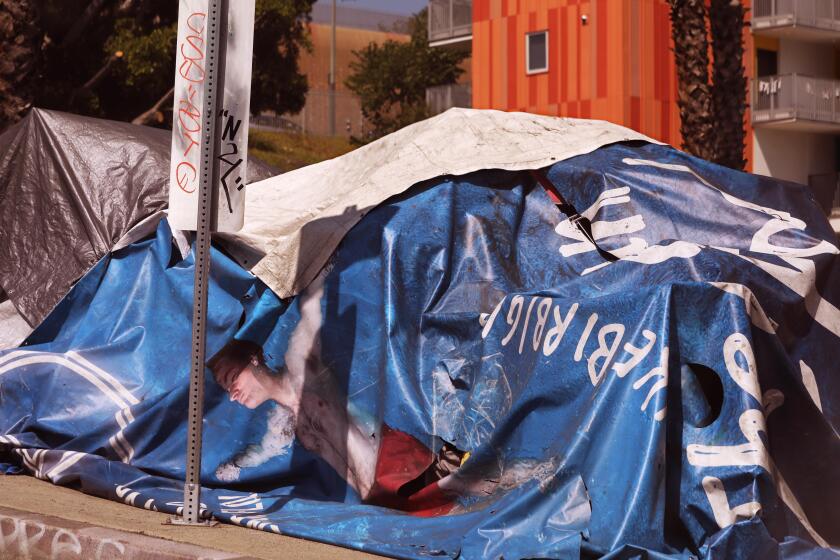A year ago, L.A. County declared homelessness a state of emergency. Is it working?

- Share via
Just over a year ago, the Los Angeles County Board of Supervisors, following Mayor Karen Bass’ lead, declared a local emergency on homelessness in an effort to inject a sense of urgency into addressing the needs of the almost 76,000 unhoused people spread across America’s largest county.
On Tuesday, the supervisors heard from Cheri Todoroff, executive director of the L.A. County Homeless Initiative, who said the emergency order declared in January 2023 “absolutely is working.”
Last year, 23,664 people in L.A. County were placed in permanent housing, such as apartments, an 18% increase over 2022, according to data from the Homeless Initiative.
An additional 37,505 people were moved to interim housing, which includes hotels, motels and some shelters, a 15% increase over 2022, according to the county.
Todoroff said this is likely an undercount because not all 2023 data has been compiled. Additionally, some of those counted as moving into interim housing in 2023 could be counted twice if they also moved into permanent housing the same year.
As her Inside Safe program enters its second year, Bass said she is determined to clear the bottleneck keeping homeless residents from getting into permanent homes.
The totals include about 1,800 people housed by 38 Inside Safe operations, the mayor’s program, which received help from county agencies. County officials did not disclose the number of people who exited interim or permanent housing during Tuesday’s presentation.
Last year’s annual point-in-time count showed there were an estimated 75,518 people living in interim housing or a tent, car, van, RV or makeshift shelter in L.A. County, up from 69,144 the previous year. The biggest increases were seen in East and West L.A., and the South Bay’s Harbor region.
Todoroff was clear in the biggest challenge ahead.
“The driving force of homelessness is a lack of affordable housing,” said Todoroff, who has worked for the county for 35 years. “In Los Angeles County, we’re currently experiencing a massive housing deficit of over 500,000 affordable homes.”
The county has a reputation for being slow to hire, and the emergency powers granted department heads authority to cut through red tape in hiring, Todoroff said.
In 2023, the amount of time it took the county to hire someone was cut by 77%, down to about two months, according to county data. In the last two months of 2023, more than three people were hired each day, the county said.
The county Department of Mental Health reduced its hiring time from about 304 days to 53 days, the county said. This included hiring for its homeless outreach teams that visit unhoused people with serious mental illnesses. The agency had previously struggled to fill those positions but in 2023 was able to double the number of teams from nine to 18.
Policymakers including the Board of Supervisors and Mayor Karen Bass promised to address homelessness. Department of Mental Health vacancies hold them back.
More than 1,000 shelter beds were added for people with mental health and substance use disorders or in need of more intensive care management.
The county also spent money on homelessness prevention, providing legal services to 22,000 households.
The biggest sticking point for the supervisors Tuesday was how to make the county’s Pathway Home encampment cleanup program successful.
In October, the supervisors lamented how the program had been set up only in August, taking almost a year from the time the supervisors asked for the program to get rolling.
Los Angeles County supervisors were displeased Tuesday to hear how slow county departments have been to address the region’s homelessness crisis.
Since August, the county has carried out 10 Pathway Home encampment cleanups. A total of 443 people were moved from encampments to interim housing, such as motels, and 56 went into permanent housing. Workers removed 206 “unsafe” RVs from encampment communities.
“These are successful — you get the hotel rooms, you do a lot of outreach and then on that day you have the van there, and you tell everybody, ‘It is moving day — we are taking you, we are taking your belongings, as many as we can, and we are moving the entire village encampment neighborhood community into a motel or hotel,’” Supervisor Janice Hahn said. “But we’ve only managed to do 10.”
Hahn asked what it would take for the county to execute a weekly Pathway Home encampment cleanup.
Todoroff said because the board recently approved Measure H and state money through the next fiscal year for the program, she anticipates being able to carry out a Pathway Home operation once every week and a half. “So that scale is happening,” Todoroff said.
That would mean an estimated 38 Pathway Home encampment operations this year, serving 1,800 people and removing at least 300 RV encampments from roadways.
Other supervisors reiterated the importance of those cleanups.
“We can’t wait for you to get to East Los Angeles,” Supervisor Hilda L. Solis said.
More to Read
Sign up for Essential California
The most important California stories and recommendations in your inbox every morning.
You may occasionally receive promotional content from the Los Angeles Times.














